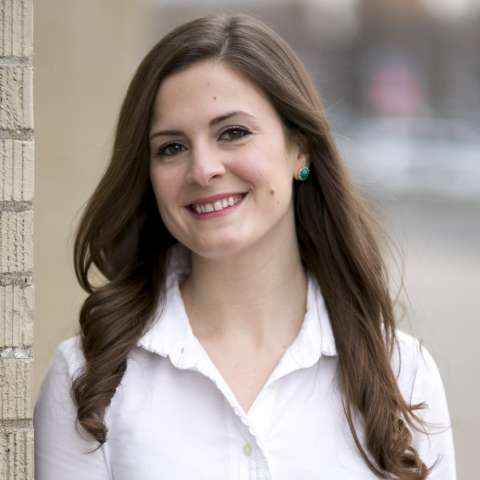When planning for the 2012/13 season, Artistic Director Mikko Nissinen could not have known how incredibly well-timed Chroma would seem for the Boston community. Following last month’s tragic events, the three selections comprising Chroma appear poised to lift the collective Bostonian spirit – it is a program that reflects on the past, reassuring the audience that traditions remain strong but that the future too is bright and brings with it a fresh new outlook.
There was a collective intake of breath as the curtain rose on George Balanchine’s Serenade with the heart-wrenching opening notes of Tchaikovsky’s score – seventeen dancers in long tulle skirts, scattered about the stage, standing with one arm extended, palms flexed, gazing over their fingertips into a bathing blue light. This poignant yet simple scene evokes an incredible reaction from the viewer, and in this piece, Balanchine continuously and effortlessly arouses a range of emotions that leave the audience breathlessly yearning for more.
It is perhaps because of its humble beginnings as a piece choreographed on the students of the School of American Ballet that Serenade maintains an endearing level of innocence that charms and conjures an incredibly strong sense of nostalgia. It is built on the strength of the corps de ballet with sweeping formation changes, synchronized movements and occasional entwining limbs that emphasize the solidarity of the dancers. However, Rie Ichikawa leaves a lasting impression as a solo dancer – her sprightly and spirited movements contrast beautifully with the sweeping and collaborative arrangements of the corps. In the final scene, when Ichikawa is lifted by three male dancers and carried off with outstretched arms and head tilted back once again into the bathing blue light, she is seemingly leaving behind the youthful enthusiasm from earlier in the piece and a calm melancholy pervades the theater as the curtain closes.
Chroma, choreographed by Wayne McGregor, is the second ballet in the program and creates an incredible contrast with Serenade. This work, which was originally premièred by The Royal Ballet in 2006, is an exhilarating, energetic, and athletic piece that thrusts the audience into the future of contemporary ballet and showcases the remarkable range of the company. The stage is encased in a sterile white with a wide rectangular opening at the rear against which dancers are silhouetted as they enter through the space. The start of the ballet is signaled by the building of a faint tinkling triangle, a dancer sinuously snaking her torso repeatedly towards the ground, and then the blaring notes of the opening of a dazzling and percussion-heavy score (so heavy indeed that percussionists were distributed to loge boxes in the theater) by Joby Talbot and Jack White. McGregor’s award-winning choreography features dramatic extensions, imaginative partnering, and enough quirks to keep the audience on its toes. McGregor challenges the gender roles of traditional ballet by setting distinctly feminine movements on male dancers, featuring same-gendered partnering, and emphasizing the androgyny of the piece by clothing the dancers, male and female alike, in the same sparse outfits.
In my opinion, Boston Ballet is at its finest in contemporary pieces. Soloists Adiarys Almeida and Bo Busby shine in an aggressive duet as they move effortlessly together in a demanding passage where their bodies remain connected for an extended length of time – morphing through jagged and rigid poses into fluid lifts, the audience is treated to a showcase of the incredible capabilities of their bodies that classical ballet cannot always display.
Closing out the program is a second Balanchine ballet, Symphony in C. This work, choreographed in just two weeks following Balanchine’s acquisition of the Georges Bizet symphony, harkens back to Balanchine’s Russian roots with a demanding, quick-tempo display of technical classicism. The ballet, in four parts, culminates in a rousing finale with 52 dancers performing synchronized steps and fluently completing Balanchine’s signature (and frequent) formation changes. For those lamenting the dearth of tutus in the first two ballets, Symphony in C delivers grandly, with all the ladies donning classically beautiful “powder-puffs”, a style of tutu originally designed for this particular ballet in 1950.
Adiarys Almeida returns in this piece, executing challenging turning combinations with ease, and a sprightly Isaac Akiba effortlessly sailed through jumping passes. Principal dancer Lia Cirio, was slightly shaky when she opened the second movement but quickly regained her composure for a sure-footed return in the finale, dazzling in turning combinations with the three other leading ballerinas (a captivating Kathleen Breen Combes and Seo Hye Han rounding out the quartet). The comfort of the predictable and traditional holds sway in this piece and when all 52 dancers simultaneously hit their final poses, the audience erupts with a well-deserved gush of applause. Chroma is truly a magnificent program that reflects and inspires, leaving the viewer with a calm yet energized mind, and certainly a lighter spirit.


